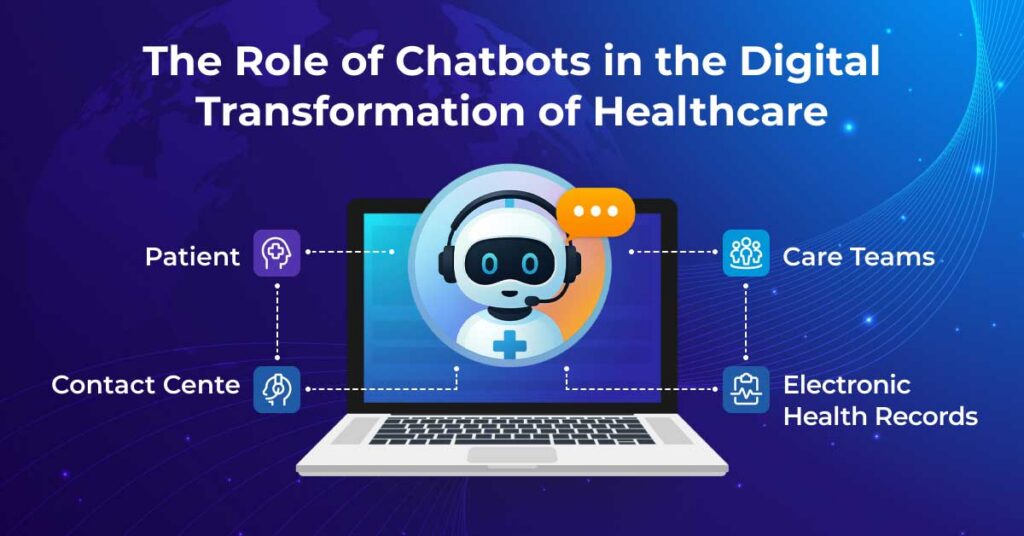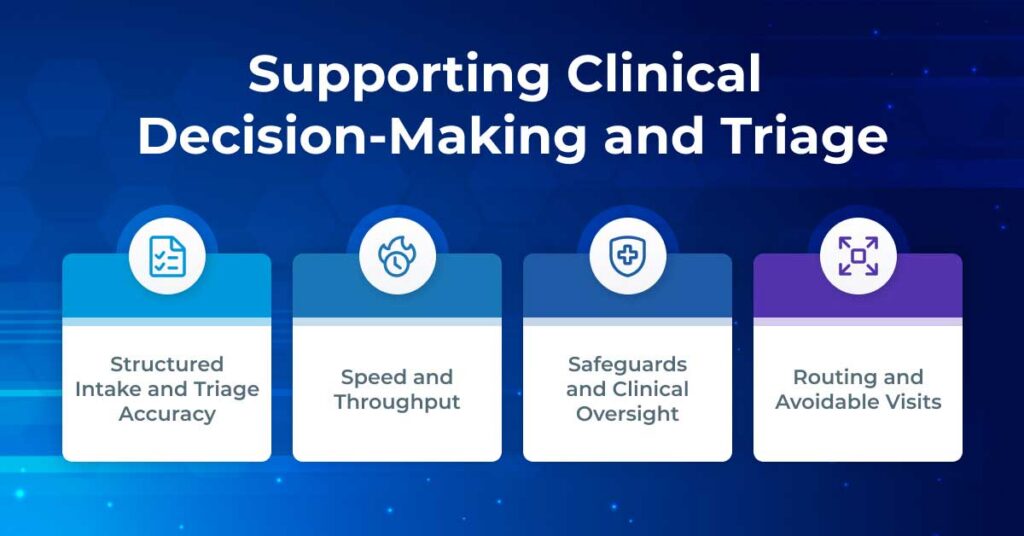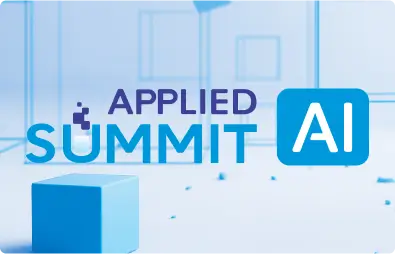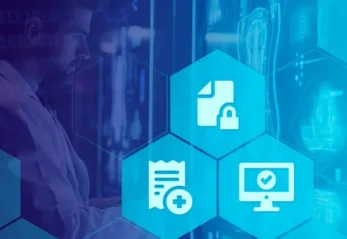Introduction
Health systems are being asked to deliver faster access with fewer clinical resources. A projected shortfall of 86,000 physicians by 2036 signals that expanding capacity will depend less on hiring more staff but on finding smarter, automated ways to manage patient demand and throughput.
Every minute spent answering routine questions or managing scheduling tasks is a minute taken from direct care. Traditional workflows can no longer keep up with rising demand or the expectations of a digitally connected patient population.
Medical chatbots are emerging as a new layer of healthcare infrastructure that supports this shift. These AI-powered assistants guide patients, collect information, and manage follow-up communication while maintaining the privacy and accuracy standards required of clinical systems.
This article explores how medical chatbots are transforming patient access and operational efficiency and why secure, purpose-built automation is becoming essential to meet the demands of modern healthcare.
What is a Medical Chatbot?
A simple definition of a medical chatbot is an AI assistant built for healthcare settings. It communicates securely with patients and staff, connects to clinical systems, and handles Protected Health Information (PHI) within HIPAA-compliant standards. Unlike generic bots, it understands medical terminology and fits into regulated workflows without adding risk.
A healthcare AI chatbot allows one digital assistant to handle thousands of patient interactions simultaneously. It manages scheduling, eligibility checks, and follow-ups that would otherwise require multiple staff members. This directly lowers the cost per encounter while improving response times and patient satisfaction.
The adoption of healthcare chatbots reflects a wider shift toward automation that expands capacity, maintains compliance, and keeps patient access teams focused on higher-value work.
The Role of Chatbots in the Digital Transformation of Healthcare

Chatbot technology is now a central part of the broader digital transformation in healthcare. It strengthens how patients and staff communicate by providing fast, accurate, and secure support across multiple digital touchpoints.
In large health systems, a medical chatbot can connect contact centers, care teams, and electronic health records to create a single, responsive channel for routine interactions. An AI medical chatbot can register patients, triage basic requests, confirm insurance details, and follow up after appointments.
Each automated exchange generates structured data that improves reporting, resource planning, and service quality. This level of healthcare automation reduces administrative workload, shortens response times, and improves consistency in patient communication.
If you plan to use generative AI in healthcare, the latest models now provide higher accuracy and stronger safeguards.
Agentic AI powered by healthcare LLMs enables chatbots to interpret medical context, pull verified information, and generate responses that are traceable and audit-ready. These capabilities make AI systems safer to deploy in regulated environments and more reliable for clinical and operational use.
A medical chatbot powered by NLP Tools, demonstrates how this works in practice. It combines advanced language processing with privacy-by-design architecture to improve patient access, operational efficiency, and the overall digital maturity of healthcare organizations.
Enhancing Patient Engagement and Accessibility

Improving patient engagement in healthcare is now central to every digital transformation effort. Patients expect quick, convenient, and reliable communication with their care teams. Traditional systems often fall short, limited by opening hours, language barriers, and long response times. Chatbots address these issues by providing accessible healthcare solutions that make information and services easier to reach.
24/7 Availability
One of the main benefits of chatbots in healthcare is 24/7 patient support. A chatbot can confirm appointments, answer common questions, and share follow-up details at any time. This helps patients get assistance when they need it without waiting for office hours, creating a more responsive service experience.
Improving Patient Access Through Multilingual Communication
Multilingual chatbots improve communication for patients who prefer languages other than English. They offer translation and culturally aware responses, allowing them to communicate healthcare information in a clearer and more inclusive way.
Omnichannel Communication
Patients want to connect through the channels they already use, whether text, web chat, or phone. Chatbots unify communication across platforms, making it easier for patients to reach support and for healthcare staff to manage requests efficiently.
Personalized Support
A medical chatbot can tailor communication using patient data such as appointment schedules or test reminders. Personalized messages make interactions more relevant and help patients follow their care plans with greater confidence.
AI-driven assistants perform best when they draw from verified medical knowledge. A medical research chatbot can help organizations surface peer-reviewed evidence quickly, ensuring that automated interactions stay aligned with current clinical understanding. Paired with trusted healthcare datasets, it strengthens the reliability of chatbot workflows across patient education, triage, and follow-up.
Reducing Administrative Workload for Medical Staff

Administrative costs account for roughly 25% of total healthcare spending in the United States, driven by manual scheduling, documentation, and call handling. A medical AI chatbot helps offset these costs by automating healthcare tasks that consume staff time, allowing clinical teams to focus on direct care.
Automating Repetitive Work
Nurses, call center agents, and administrative staff spend much of their day on repetitive, structured tasks such as booking appointments, verifying insurance, and processing medication refills. These actions rely on data already stored in electronic health records (EHRs) or scheduling systems, making them ideal for automation.
A medical AI chatbot can connect securely to these systems and handle many of these tasks automatically. It can check appointment availability, confirm patient details, route messages, and send follow-up reminders without involving staff. By reducing administrative workload, chatbots free frontline teams to focus on complex cases where human judgment adds the most value.
Scheduling Automation and Follow-ups
Appointment coordination is one of the most resource-intensive workflows in healthcare. Chatbots can automate scheduling by integrating directly with EHR systems. Patients can confirm, reschedule, or cancel appointments in real time without staff intervention.
Automated reminders and follow-ups make it easier for patients to stay on track with their care.A Canadian survey found that patients preferred electronic scheduling and reminders for their convenience and time savings, which directly reduced missed appointments.
Smart Handoffs and Context Sharing
Automation complements human work when supported by smart escalation. Suppose the chatbot needs to answer a complex question (about billing or detailed care instructions). In that case, it can transfer the converzation to a live agent with full context, including the chat transcript and patient details. This prevents repetition and shortens handling times.
Chatbots equipped with the DocQA Feature in Medical Chatbot extend automation further by retrieving answers directly from verified documents, reducing time spent searching for policies or care protocols.
Supporting Clinical Decision-Making and Triage

Effective triage begins with collecting clear, detailed patient information. A clinical chatbot asks targeted questions, records symptoms, and flags urgent warning signs before a clinician reviews the case. In hospitals and urgent care centers, chatbots for triage strengthen clinical decision support by gathering reliable data, reducing intake errors, and moving patients to the right care setting faster.
Structured Intake and Triage Accuracy
Chatbots follow approved triage protocols to run structured symptom assessment. They ask specific questions about when symptoms started, how severe they are, and whether the patient has red flags such as chest pain or breathing difficulty. This process ensures that every patient provides the same core information, improving the accuracy of the clinician’s assessment.
In a 2022 emergency department study, patients first used a triage chatbot before seeing a doctor. When researchers compared results, they found the chatbot identified the same final diagnosis as physicians in 70% of cases, nearly matching doctors, who reached 68.9% accuracy with the same information.
Speed and Throughput
Digital triage tools reduce the time patients spend waiting for evaluation. In one study, 97% of patients used self-triage kiosks when available, and hospitals that deployed them reported shorter time-to-triage and time-to-physician intervals. In primary care, chatbots that collect patient histories before appointments let clinicians focus directly on diagnosis and treatment instead of initial questioning.
Routing and Avoidable Visits
AI-powered triage provides health systems with a structured approach to directing patients based on medical urgency. Chatbots can schedule next-day virtual appointments for mild symptoms and immediately escalate serious cases to emergency teams.
During the COVID-19 pandemic, hospitals used chatbots to screen millions of patients. Those with mild symptoms were advised to isolate and monitor oxygen levels, while high-risk individuals were urged to visit the emergency department.
Clinician-supervised COVID-19 chatbots, updated with current public health guidance, likely saved lives by prompting timely emergency visits before conditions became critical. They supported clinicians during surges by managing high inquiry volumes, reducing overcrowding, and helping critical patients receive treatment sooner.
Safeguards and Clinical Oversight
Each clinical chatbot operates within approved clinical guidelines and pulls information only from verified medical sources. Benchmarks comparing John Snow Labs vs GPT-4 in biomedical question answering show how grounding AI in verified medical data improves accuracy and safety. In critical cases, clinical chatbots can record patient summaries while interacting with them and escalate the case to clinicians themselves.
Use Cases and Real-World Examples of Healthcare Chatbots
Peer-reviewed research literature shows there are several healthcare chatbot use cases that demonstrate measurable results across clinical care, patient engagement, and operations. Each chatbot in healthcare serves a specific function that helps providers improve outcomes and reduce workload.
Chronic Care Management
In chronic care management, chatbots help patients manage long-term conditions such as diabetes or hypertension. They prompt glucose checks, medication reminders, and symptom updates.
A JMIR review of 25 studies found that diabetes chatbots improved blood sugar control and self-management compared with standard care. These automated touchpoints reduce the time clinicians spend on follow-ups while keeping patients consistent with their daily routines.
Patient Triage and Digital Navigation
Chatbots for triage collect structured symptom information and guide patients to the right level of care. Research confirms that clinician-supervised chatbots can safely support triage and patient communication when deployed with clear boundaries and oversight. Studies also show that LLMs integrated with guardrails can perform on par with clinicians in specific triage classification tasks.
Multimodal AI frameworks such as VLM-24B enhance this process by combining text and image inputs. This allows for faster and more accurate evaluation of symptoms before escalation.
Perioperative Education and Follow-Up
Before and after surgery, chatbots provide preparation checklists, explain recovery steps, and monitor patient responses. A 2024 systematic review found high patient satisfaction with perioperative chatbots and no reported safety concerns. Randomized trials confirmed that AI-assisted follow-ups were just as effective as nurse calls. This allowed hospitals to manage recovery checks efficiently and at scale.
Medication and Care-Plan Adherence
Medication chatbots embedded in patient portals send personalized reminders for prescriptions, exercises, and therapy tasks. A 2023 JMIR review found higher adherence rates among users who received automated messages.
When connected to EHR and pharmacy systems, chatbots can verify refills and track progress. Platforms like the Generative AI Lab help healthcare organizations build customized medical GPT models that enable this level of personalization.
Mental Health Chatbot Support
A mental health chatbot provides evidence-based self-help for anxiety and depression. It delivers structured prompts based on cognitive behavioral therapy, tracks mood patterns, and flags high-risk responses for human review.
A 2023 NPJ Digital Medicine review of 15 randomized trials found meaningful reductions in depression and anxiety scores. Designed with privacy controls and clear escalation routes, these chatbots extend access to psychological support between therapy sessions.
Addressing Trust, Privacy, and Compliance
Ensuring patient trust in healthcare automation requires organizations to enforce strict control of data, full auditability, and compliance with established privacy frameworks. Medical chatbots must meet the same standards as any system handling Protected Health Information (PHI).
Keeping PHI Within Governed Environments
Chatbots that handle PHI must operate inside environments covered by Business Associate Agreements (BAAs) and formal risk analyses. HIPAA allows public, private, or hybrid cloud setups if organizations implement the right controls for data privacy in healthcare, including encryption, risk analysis, and formal BAAs.
Even “no-view” encrypted hosting requires a BAA because the cloud vendor still counts as a business associate under HHS guidance. To stay compliant:
- Prohibit ad pixels, tracking scripts, or third-party analytics on chatbot pages that process PHI.
- Treat any interaction containing health data as PHI unless covered by a BAA.
- Validate that all systems storing chatbot logs, embeddings, or vector data meet HIPAA and GDPR requirements.
Ensuring Every Action Is Auditable
HIPAA’s Technical Safeguards require access control, authentication, integrity checks, and audit trails. In practice, this means recording every chatbot interaction, such as:
- Who accessed the data
- What was viewed or modified
- When was the data accessed
Logs must include prompts, responses, and retrieval events, all stored securely for later review. To demonstrate compliance:
- Apply role-based access control and multifactor authentication for administrators.
- Retain immutable system logs and review them as part of regular audits.
- Link chatbot audit data with your organization’s SOC and healthcare compliance reports.
Using De-Identification to Enable Research
Healthcare organizations can safely use chatbot data for research by de-identifying it according to HIPAA or GDPR standards. HHS recognizes two methods:
- Safe Harbor: removing 18 identifiers such as names, contact details, and geographic data.
- Expert Determination: verifying and documenting a very small risk of re-identification.
Once de-identified, data can be used for model improvement or analytics without additional authorization. For EU or UK programs, GDPR Recital 26 and ICO guidance confirm that anonymized data falls outside data protection laws.
To apply this correctly:
- Maintain a separate de-identification pipeline to isolate PHI from research data.
- Document which identifiers were removed and by what method.
- Store de-identified datasets only in approved research or model-training environments.
Building Confidence Through Transparent Design
A compliant medical chatbot must show clear accountability at every step. Users should know their information is processed securely, governed under HIPAA and GDPR, and traceable through audit logs.
The Future of Chatbot Technology in Healthcare
The future of healthcare chatbots lies in systems that can anticipate patient needs, collect accurate information, and act immediately when new data becomes available. These tools help hospitals and clinics reduce missed appointments, improve communication, and manage patient flow with greater efficiency.
Agentic, Event-Triggered Chatbots for In-Workflow Action
Future medical AI chatbots will move from responding to requests to acting proactively inside clinical systems. These event-triggered tools will detect key moments in the EHR (like a missed referral, no-show, or abnormal lab result) and create auditable follow-up actions.
For example, the chatbot could draft a message to the patient or prepare an order for clinician review, showing exactly what triggered the action and which guideline it followed.
Predictive Outreach and Early Intervention
A medical AI chatbot can now be trained to analyze scheduling and EHR data to identify patients at risk of missing appointments or delaying treatment. It could then send reminders, rescheduling links, or personalized messages that encourage timely care. This kind of predictive healthcare support has the potential to reduce no-shows and improve how health systems use available capacity.
Multimodal Interaction: Voice, Image, and Document Capture
Future chatbots will handle more than text. Patients will describe symptoms by voice, upload referral letters or insurance cards, and share photos of wounds or skin conditions for quick review.
Voice-based chatbots can take short medical histories or route calls to the right department. These multimodal healthcare solutions allow for more natural communication and faster data capture while maintaining accuracy and safety through clear verification and escalation processes.
Real-Time Integration with Clinical Systems
Modern chatbots will integrate directly with EHR and EMR systems to act the moment patient data changes. FHIR Subscriptions can help trigger automatic chatbot actions such as sending reminders or sharing new information. SMART Web Messaging enables chatbots to display updates within clinical dashboards, while FHIRcast maintains synchronization across different systems.
John Snow Labs’ Medical Chatbot Solution: Advanced AI for Healthcare
Powered by John Snow Labs’ medical LLMs, the Medical Chatbot is purpose-built for clinical, research, and administrative use across healthcare settings. It combines healthcare-trained language models with daily-updated medical sources and enterprise-grade security controls.
Unlike general AI tools such as Google MedLM, Microsoft Nuance DAX Copilot, or Infermedica, it is trained entirely on clinical and biomedical data. This specialization delivers domain accuracy, transparent answers, and deployment flexibility within private or governed cloud environments.
Commercial AI tools lack these enterprise-grade safeguards, as they depend on shared cloud infrastructure and external data processing that cannot always guarantee compliance with HIPAA, GDPR, or internal IT governance policies.
Here are the core features that make Medical Chatbot a trusted solution across clinical, research, and operational settings.
- Evidence-Based Answers: Provides responses backed by citations from daily-updated sources such as PubMed, medRxiv, and bioRxiv. Leaders get transparent, verifiable outputs they can use in clinical reviews, governance discussions, and regulatory audits.
- Healthcare-Specific Capabilities: Supports medical converzations, literature review, and document Q&A across formats including PDF and Word. Clinicians and analysts cut down research time by querying complex material directly instead of searching through multiple systems.
- Enterprise Deployment and Governance: Runs as SaaS or on-premise with role-based access, single sign-on, and full API integration. Health systems maintain HIPAA- and GDPR-aligned control while embedding the Medical ChatBot into existing Epic/Cerner, ServiceNow, and analytics workflows.
- Custom Data Integration: Connects securely to private knowledge bases such as care pathways, clinical guidelines, SOPs, formulary documents, and patient encounter notes. Teams can search organizational knowledge at scale and retrieve consistent answers without relying on manual lookups.
- Scalable Architecture: Processes millions to billions of documents with ranked references and safeguards that reduce hallucinations. Enterprise teams can conduct research, literature review, and document Q&A without performance degradation, even during peak demand.
Key Takeaways
Healthcare chatbots have become a central part of digital healthcare solutions. They improve access, streamline operations, and enhance patient care by reducing administrative workload, supporting clinical decisions, and providing accurate, multilingual information around the clock.
With medical AI evolving rapidly, now is the time to adopt solutions that deliver safety, precision, and scalability. Deploying secure, explainable, and healthcare-trained chatbots helps organizations improve care quality, meet compliance standards, and modernize patient access.
Schedule a custom demo to learn how John Snow Labs can help you implement trusted medical chatbots that deliver measurable improvements in operational efficiency and patient outcomes.
FAQs
How are chatbots used in modern healthcare?
Healthcare chatbots now support operations across the entire care journey. They manage front-door access by answering questions, routing patients, and booking appointments. Clinicians use them to search medical literature or extract answers from documents, while operational teams rely on them for prior-authorization reviews and eligibility checks.
Are healthcare chatbots safe to use?
When designed for information and administrative support, chatbots are safe and compliant. Effective systems include source citations, document-grounded responses, audit logs, de-identification, and human oversight for sensitive cases.
However, if a chatbot provides diagnostic or treatment recommendations, it falls under FDA Software as a Medical Device (SaMD) regulations and must meet those standards. Human supervision and clear escalation remain essential for clinical use.
Can chatbots replace medical professionals?
Chatbots complement clinicians rather than replace them. They reduce search and administrative time, surface verified evidence with citations, and standardize routine workflows. Clinical decision-making, consent, and accountability always remain the responsibility of licensed professionals. Regulators classify AI models as assistive tools, not replacements for medical expertise.
Who benefits from medical chatbots?
Healthcare chatbots now serve a wide range of users across clinical, research, and operational settings. Their value lies in reducing repetitive work, improving access, and turning unstructured information into actionable insight.
- Health systems and clinics: Improve patient access, streamline education, and answer policy or protocol questions while supporting clinician research.
- Research and life sciences teams: Summarize and analyze medical literature with verified citations to accelerate evidence reviews.
- Revenue cycle and utilization management: Simplify prior-authorization and claims review by applying document-grounded reasoning and structured audit trails.
What are the key benefits of healthcare chatbots?
Healthcare chatbots integrate directly with existing systems and actively improve operational efficiency and patient experience across large health networks. They streamline communication, automate routine tasks, and deliver accurate information at scale.
- Verified answers with citations: Every response links directly to its medical source, ensuring transparency and reliability.
- Document-based Q&A: DocQA retrieves precise answers from uploaded files, reducing manual document review.
- Improved patient access: Self-service chat enables faster support for routine requests and frees staff to focus on complex care.
How will chatbot technology in healthcare evolve?
Healthcare chatbots are moving toward deeper integration and smarter automation. Future models will connect directly with EHRs and internal knowledge systems, use de-identified and auditable data for safety, and apply predictive analytics to anticipate patient needs. Real-time event-driven orchestration and stronger regulatory oversight will further align these systems with FDA and HIPAA requirements.
What makes John Snow Labs’ medical chatbot different?
John Snow Labs offers a purpose-built solution designed specifically for healthcare rather than adapted from general AI models.
- Built for healthcare: Trained on clinical and biomedical data, the chatbot delivers domain-accurate answers with daily-updated citations.
- Document Q&A (DocQA): Users can upload PDFs or text files and receive clear, reference-linked answers grounded in their own data.
- Enterprise deployment options: Available as a secure private managed service or on-premise solution that integrates with existing systems.
- Protected health information (PHI) safeguards: Combines de-identification tools and HIPAA-compliant controls to protect sensitive medical data.
Together, these capabilities give organizations a compliant, explainable, and scalable medical chatbot that improves operational efficiency and patient outcomes across healthcare networks.


























